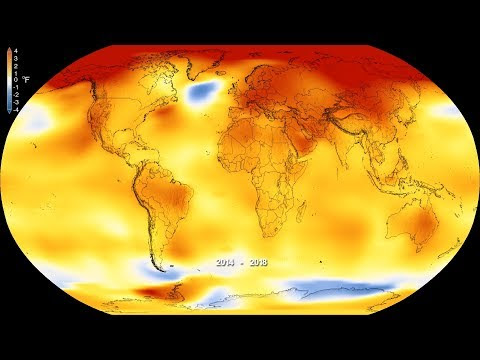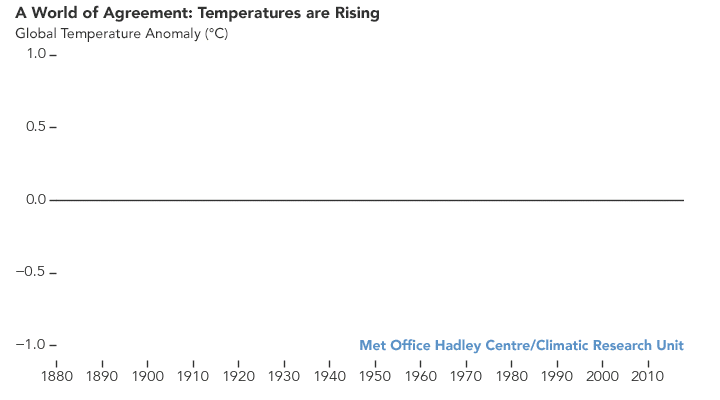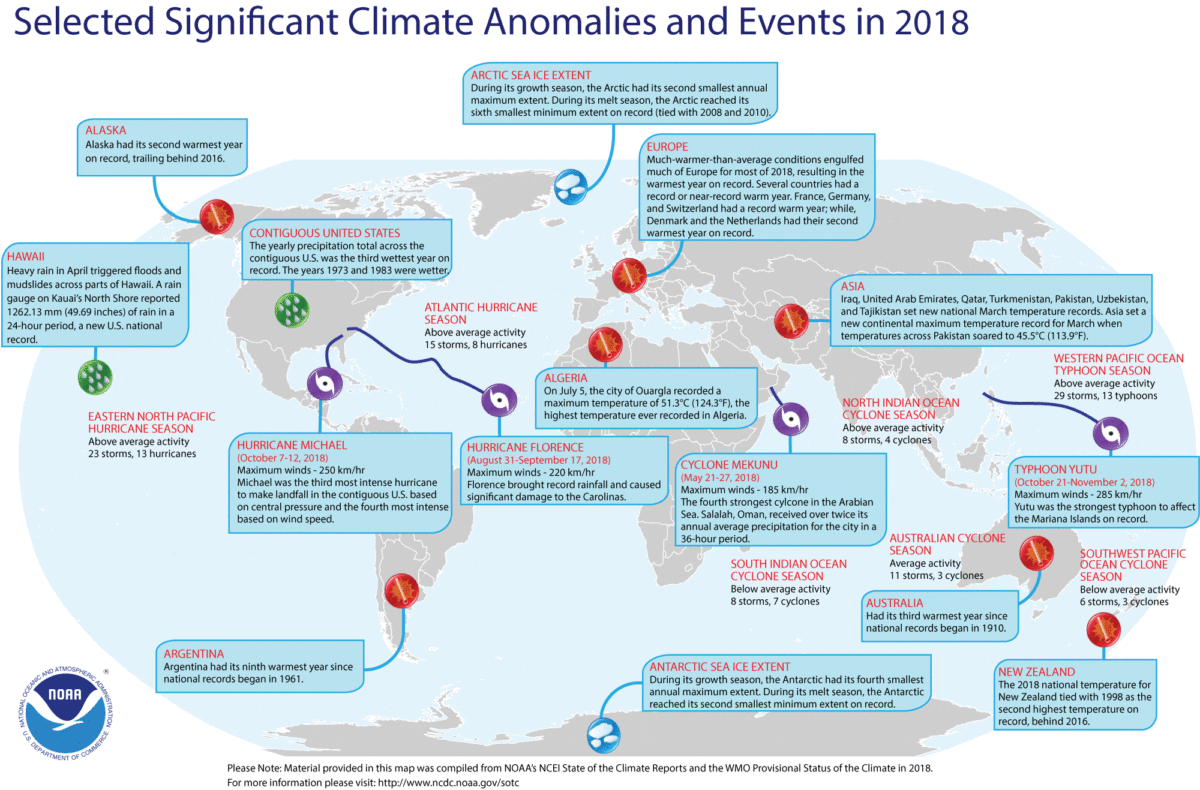
Earth’s long-term warming trend can be seen in this visualization of NASA’s global temperature record, which shows how the planet’s temperatures are changing over time, compared to a baseline average from 1951 to 1980. The record is shown as a running five-year average: NASA’s Scientific Visualization Studio/Kathryn Mersmann
By Glynn Wilson –
In direct contradiction to the public position of the president of the United States, two of the federal agencies charged with monitoring the science on climate change released a joint statement and a report on Wednesday declaring unequivocally that the effects of human-induced global warming from the burning of fossil fuels is already having a negative impact on the planet and life on Earth.
In what could be seen as defiance of an executive order from President Donald Trump not long after he took office in 2017 banning federal agencies from publishing and publicly talking about data on climate change and global warming, the report presents evidence from the past 130 years and shows that since the 1880s, the average global surface temperature has risen about 2 degrees Fahrenheit, or 1 degree Celsius, according to a joint release from the National Aeronautics and Space Administration (NASA) and the National Oceanographic and Atmospheric Administration (NOAA).
This was considered a catastrophic level when it was projected back in the 1990s.
“The impacts of long-term global warming are already being felt — in coastal flooding, heat waves, intense precipitation and ecosystem change,†said Gavin Schmidt, director of NASA’s Goddard Institute for Space Studies, in a statement about the report. “This warming has been driven in large part by increased emissions into the atmosphere of carbon dioxide and other greenhouse gases caused by human activities.”
So far there is no Twitter tweet response on the report from Donald J. Trump, at least for now still the president, since he is still focused on the ratings and the polls from his State of the Union Address Tuesday night. There was no mention of climate change or global warming as a national crisis or global security threat in the speech, although Trump did continue to talk about his demand for a wall on the southern border of the U.S., which his own intelligence officials say is not a national security threat, a crisis or an emergency, while climate change is in the latest Global Threat Assessment.
Trump may not be president much longer, however, since he faces no less than 17 different investigations for obstruction of justice, violating the emoluments clauses of the Constitution, for violations of campaign finance laws for paying off a porn star during the 2016 election for an extramarital affair of a sexual nature and lying about it. Then there is the potential charge of treason for colluding with a foreign power, Russia, to undermine American democracy and tamper with the outcome of an election.
Meanwhile, no matter what opinions politicians have on the subject, the scientific data shows that the past five years, collectively, were the warmest years on record, according to scientists and federal agencies.
Schmidt said 2018 was “yet again an extremely warm year on top of a long-term global warming trend.”

This line plot shows yearly temperature anomalies from 1880 to 2018, with respect to the 1951-1980 mean, as recorded by NASA, NOAA, the Japan Meteorological Agency, the Berkeley Earth research group, and the Met Office Hadley Centre (UK). Though there are minor variations from year to year, all five temperature records show peaks and valleys in sync with each other. All show rapid warming in the past few decades, and all show the past decade has been the warmest: NASA’s Earth Observatory
Earth’s global surface temperatures in 2018 were the fourth warmest since 1880, according to independent analyses by NASA and the NOAA.
Global temperatures in 2018 were 1.5 degrees Fahrenheit (0.83 degrees Celsius) warmer than the 1951 to 1980 mean or average temperature. Globally, 2018’s temperatures rank behind those of 2016, the hottest year ever, and 2017 and 2015.
Warming trends are strongest in the Arctic region, where 2018 saw the continued loss of sea ice as glacier melt near the poles accelerates. The mass loss from the Greenland and Antarctic ice sheets continued to contribute to sea level rise, according to the report.
“Increasing temperatures can also contribute to longer fire seasons and some extreme weather events,” Schmidt pointed out.
Weather dynamics often affect regional temperatures, NASA qualified, so not every region on Earth experienced similar amounts of warming. Data shows that the 2018 annual mean temperature for the contiguous 48 states was the 14th warmest on record.
NASA’s temperature analyses incorporate surface temperature measurements from 6,300 weather stations, ship- and buoy-based observations of sea surface temperatures and temperature measurements from Antarctic research stations. The raw measurements are analyzed using a computer algorithm that considers the varied spacing of temperature stations around the globe and urban heat island effects that could skew the conclusions. The calculations produce the global average temperature deviations from the baseline period of 1951 to 1980.
Because weather station locations and measurement practices change over time, the interpretation of specific year-to-year global mean temperature differences has some uncertainties, NASA qualified.
“Taking this into account, NASA estimates that 2018’s global mean change is accurate to within 0.1 degree Fahrenheit, with a 95 percent certainty level,” the agencies say.
NOAA scientists used much of the same raw temperature data, but with a different baseline period and different interpolation into the Earth’s polar and other data poor regions. NOAA’s analysis found 2018 global temperatures were 1.42 degrees Fahrenheit (0.79 degrees Celsius) above the 20th century average.
NASA’s full 2018 surface temperature data set — and the complete methodology used to make the temperature calculation — are available online here.
Before you continue, I’d like to ask if you could support our independent journalism as we head into one of the most critical news periods of our time in 2024.
The New American Journal is deeply dedicated to uncovering the escalating threats to our democracy and holding those in power accountable. With a turbulent presidential race and the possibility of an even more extreme Trump presidency on the horizon, the need for independent, credible journalism that emphasizes the importance of the upcoming election for our nation and planet has never been greater.
However, a small group of billionaire owners control a significant portion of the information that reaches the public. We are different. We don’t have a billionaire owner or shareholders. Our journalism is created to serve the public interest, not to generate profit. Unlike much of the U.S. media, which often falls into the trap of false equivalence in the name of neutrality, we strive to highlight the lies of powerful individuals and institutions, showing how misinformation and demagoguery can harm democracy.
Our journalists provide context, investigate, and bring to light the critical stories of our time, from election integrity threats to the worsening climate crisis and complex international conflicts. As a news organization with a strong voice, we offer a unique, outsider perspective that is often missing in American media.
Thanks to our unique reader-supported model, you can access the New American journal without encountering a paywall. This is possible because of readers like you. Your support keeps us independent, free from external influences, and accessible to everyone, regardless of their ability to pay for news.
Please help if you can.
American journalists need your help more than ever as forces amass against the free press and democracy itself. We must not let the crypto-fascists and the AI bots take over.
See the latest GoFundMe campaign here or click on this image.
Don't forget to listen to the new song and video.
Just because we are not featured on cable TV news talk shows, or TikTok videos, does not mean we are not getting out there in search engines and social media sites. We consistently get over a million hits a month.
Click to Advertise Here

















Once again profits and vulture capitalism before the needs of the people-I find it amazing how the 99% willfully allow the 1% to dictate policies that have the ability to destroy us all…in the background one will see those who call themselves ‘conservative Christians’ who feel they have a right to plunder and exploit the earth “before Christ comes again…and removes the true believers…” These same people lament how when Islamic extremist do the exact same thing, it is so “ungodly” and wrong; but, when they (“Christians”) exhibit the same conduct and pass laws forcing their religious beliefs onto all others in a political setting-it is somehow “right and just”?